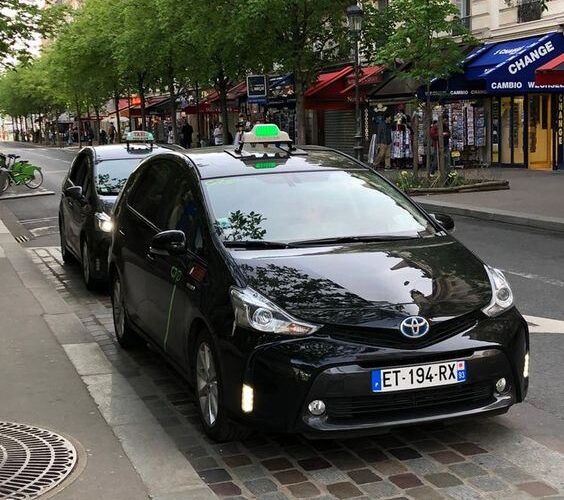Getting Around In Paris: Getting A Paris Taxi

Paris is a city of spectacular beauty, and it’s no wonder that millions of people visit every year. The French capital has been attracting tourists for centuries; if you’re in Paris for the first time, here are some things to keep in mind:
- Taxis are an essential part of getting around Paris. They’re convenient and safe–but also expensive! Make sure you know what kind of taxi service you’re using before hopping in one so that you can be prepared for any surprises (like extra fees).
- There are many different types of taxis available in Paris: regular black cabs; minivans called “vannes” or “grandes brunes”; electric cars called “electriques”; scooters with sidecars called “taxis cyclo-pousses” (these can only be hired by two people). Each type has its own regulations regarding fares and service times.
Identifying A Paris Taxi
You’re in Paris, and you want to go somewhere. You hail a taxi and get into the back seat. The driver is wearing a uniform and has a meter visible from outside the car, so it looks like everything is going smoothly. You start talking about where you want to go, but then suddenly things go south: your driver turns around and tells you that he can’t take you there because it’s too far away from his zone of operation (or “zone de circulation”). The reason why? Because he doesn’t have enough gas in his tank!
Now what? This scenario may seem unlikely–but if it happens to you or someone else who lives in Paris, here are some tips on how not only avoid getting scammed by these types of taxis but also how best handle them:
Firstly, remain calm and composed despite the unexpected situation. Politely ask the driver to drop you off at the nearest taxi stand or a location where you can easily find another taxi. If the driver insists on taking you to your destination despite the fuel issue, firmly refuse and reiterate your request to be dropped off promptly. It’s essential to prioritize your safety and avoid getting involved in any potentially risky situations. Additionally, consider reporting the incident to the relevant authorities, such as the taxi regulator in Paris, to ensure that appropriate action is taken to address the driver’s behavior and prevent similar incidents in the future.
If you’re unsure whether a taxi in Paris is legitimate, look for the distinctive “TAXI PARISIEN” sign on the roof, which indicates that the vehicle is authorized for hire. Additionally, every licensed taxi should display a unique identification number, a tariff card, and a meter visible from outside the car. It’s also advisable to check if the driver has a valid taxi driver’s license prominently displayed. If you encounter any issues or suspect foul play, don’t hesitate to note down the taxi’s identification details and report the incident to the authorities for further investigation.
Booking a Paris Taxi
There are several ways to book a taxi in Paris. The most common way is through an app, which will allow you to select the type of car you want and pay for it before you get in. You can also book directly with the driver at a taxi stand or simply hail one on the street.
If you’re using an app, check that it’s licensed by the city of Paris and has good reviews before downloading it. Some popular options include Uber (which recently faced some legal challenges), Taxis G7 and Easy Taxi.
Payment Options
Cash
Cash is the most convenient payment method, but it’s also the least secure. If you’re carrying large amounts of cash on you, it’s best to keep it in a money belt or hidden pouch under your clothing.
Credit Cards
Credit cards are accepted by most Parisian taxis, although drivers may charge an additional fee (usually 2% – 3%) for this service. If possible, avoid using credit cards as they are more likely than cash to be lost or stolen–and then charged back due to fraudulent activity!
Tips For Taking A Paris Taxi
Get your language right. If you’re not sure how to say “taxi” in French, it might be helpful to know that there are two words for taxi: taxi and remorqueur (the latter being what you want).
Be prepared to tip. In Paris, taxi drivers expect a tip–and they’ll let you know if they don’t get one! It’s customary to give about 10% of the fare as a tip; this can be paid either in cash or by credit card at the end of your ride (but not before).
Know how much to tip: While there’s no set rule on how much money should go into a driver’s pocket after taking an Uber or other rideshare service in Paris, it’s generally accepted that riders should leave around 5% of their total fare when traveling with these companies–so if your trip costs €5 ($6), then leaving €0.50 ($0.55) will suffice here too!
Rates And Fares
You can find the rates and fares for Paris taxis on the official website of the Comite des Taxis de Paris (CTP). The CTP is an independent association that regulates all taxi services in France, including those in Paris.
The minimum fare for a taxi ride within central Paris is 6 euros (or about $6.50 USD) plus 1 euro per kilometer traveled. If you’re traveling from one suburb to another, your minimum fare will be 10 euros (about $11 USD). For example: if you take a cab from Montmartre to Place de Clichy, which are both located inside central Paris but not right next to each other–you’ll pay 10 euros plus 2 euros per kilometer traveled between them (a total of 14 euros).
Making The Most Of Your Taxi Ride
When you’re in a taxi, it’s a great opportunity to ask your driver about things you don’t know. For example:
- What are some of the best sights to see in Paris?
- Where are some good places to eat? (If your driver doesn’t know, they’ll probably be able to point out another cab driver who does.)
- How do I get from here to there?
Using Taxis In The Suburbs

If you’re traveling to the suburbs of Paris, taxis are your best bet. They’re cheap and convenient, but they can be hard to find if you don’t know where to look.
The rates for suburban taxi services vary depending on which company you use–so it’s important to ask about pricing before getting into a car! Most companies charge around 20 euros per hour or 100 euros per day (plus tip). The good news is that some companies offer discounts if you book in advance online; this way, if there are any delays with public transportation or traffic jams along the way, at least your ride won’t cost too much extra money!
Taxi drivers may also offer additional services such as child seats if needed; just let them know ahead of time so there are no surprises later when paying for everything at once after reaching your destination safely at last!
Using Taxis At Night
The night is a different world in Paris. The city comes alive, and there are plenty of things to do after dark. If you’re looking for a taxi at night, here’s what you need to know:
- Safety first! Taxis are generally safe and reliable in Paris but it’s always best not to take any chances. If possible, try not to walk alone at night if your destination is far away from where you are now (especially if it’s near an area known for crime). If this isn’t possible or practical, then make sure that someone knows where you’re going and when they should expect your return home–just in case anything goes wrong with your ride home!
- If you’re looking to get home after a night out, taxis are an excellent option. They’re reliable and convenient, but they can also be expensive. For example, if you use a taxi after 8pm on Friday through Sunday nights (and sometimes other days), there will be extra charges added onto your fare because of the time of day. This is called “tarif nocturne” or “tarif de nuit.”
A Few Takeaways
Paris taxis are a great way to get around the city. They’re fast, reliable and convenient for travelers who want to see as much of Paris as possible in their limited time.
If you’re going to take a taxi, make sure you understand how much it will cost before getting into the cab. You can do this by asking your hotel or hostel staff what they think is a fair price for your trip and then negotiating with the driver once he arrives at your location (keep in mind that most drivers will try to charge more than what they originally quoted).
There are also many different types of taxis available throughout Paris: green cabs are standard cars; blue cabs are hybrid vehicles; black cabs have no meters but offer fixed rates based on distance traveled; white cabs are shared by multiple passengers traveling along similar routes at once (they tend not be very comfortable).
Know how to identify a taxi. A licensed cab will have a meter and be clearly marked as such.
Book through an app, like Uber or Taxis G7. These services can help you book a ride in advance, so you know exactly what your fare will be before you get into the car!
Be prepared to tip the driver if he does something extra for you (like helping with luggage or giving directions).
Use taxis in the suburbs if possible–they’re much cheaper than those in central Paris.
Use taxis at night: If it’s late and there aren’t many people around on foot, take one home; this way, no one will bother trying anything funny with you during your trip back home!
From One It Girl To Another, We Should Keep In Touch. Sign Up For Our Emails!
We Have So Much To Update You On. Sign Up For Exclusives, Deals And More.









